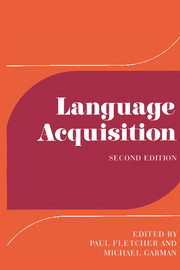Book contents
- Frontmatter
- Contents
- Contributors
- Preface
- Part I Contexts and determinants
- Introduction
- 1 Psychosocial aspects of language acquisition
- 2 Language acquisition and cognition
- 3 Language acquisition and linguistic theory
- 4 Conversations with children
- 5 Learnability
- 6 Variation in child language
- Part II The development of linguistic systems: phonology
- Part III The development of linguistic systems: grammar
- Part IV Later language development
- Notes to chapters
- Bibliography and citation index
- General index
- Titles in the series
4 - Conversations with children
Published online by Cambridge University Press: 05 June 2012
- Frontmatter
- Contents
- Contributors
- Preface
- Part I Contexts and determinants
- Introduction
- 1 Psychosocial aspects of language acquisition
- 2 Language acquisition and cognition
- 3 Language acquisition and linguistic theory
- 4 Conversations with children
- 5 Learnability
- 6 Variation in child language
- Part II The development of linguistic systems: phonology
- Part III The development of linguistic systems: grammar
- Part IV Later language development
- Notes to chapters
- Bibliography and citation index
- General index
- Titles in the series
Summary
Only ten or fifteen years ago it was thought possible to study language acquisition without studying the language addressed to children. All the research done before the late 1960s on the nature of linguistic input to children was carried out by linguists and anthropologists studying ‘baby talk’. They collected data on the special lexicon used with babies, and several noted that the baby talk words could be analysed as simplified forms of adult words (reviewed in Ferguson 1977). They also noted the characteristic prosodic features of baby talk – high pitch and exaggerated intonation contours (e.g. Blount and Padgug 1977). This research on baby talk was done primarily with the purpose of describing a certain speech register, not with any specific interest in the relevance of baby talk to language acquisition (though several papers noted that the informants justified using baby talk with a didactic motive, ‘to make the language easier to learn’). Much more recently the nature of the speech addressed to children has been studied by psychologists and linguists interested in language acquisition. They have concentrated on syntactic and semantic rather than lexical or phonological aspects of that speech, and have tended not to use the term ‘baby talk’ to refer to their object of study. Other terms have been coined, such as ‘motherese’, which gives the misleading impression that only mothers talk in a special way to children.
- Type
- Chapter
- Information
- Language AcquisitionStudies in First Language Development, pp. 69 - 89Publisher: Cambridge University PressPrint publication year: 1986
- 52
- Cited by



